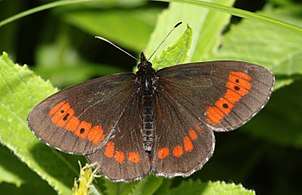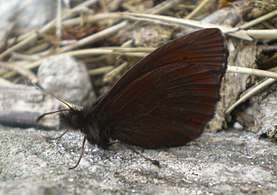Erebia euryale
Erebia euryale, the large ringlet, is a species of butterfly belonging to the family Nymphalidae.
| Large ringlet | |
|---|---|
| Upperside | |
| Underside, female | |
| Scientific classification | |
| Kingdom: | |
| Phylum: | |
| Class: | |
| Order: | |
| Family: | |
| Genus: | |
| Species: | E. euryale |
| Binomial name | |
| Erebia euryale (Esper, 1805) | |
| Synonyms[1] | |
|
List
| |
Subspecies
Subspecies include:[1]
- Erebia euryale adyte Hübner, 1822 (central and southern Alps, Swiss Jura and parts of Abruzzo)
- Erebia euryale etobyma Fruhstorfer, 1910
- Erebia euryale euryale (Esper, 1805) (northern Alps)
- Erebia euryale huebneri Oberthür, 1912
- Erebia euryale isarica Heyne, 1895 (northern Alps, Switzerland, France)
- Erebia euryale ocellaris Staudinger, 1861 (eastern and southern Alps)
- Erebia euryale syrmia Fruhstorfer, 1909 (Balkan Peninsula, Bulgaria, Romania)
Distribution and habitat
This species is endemic to Europe. It can be found in southern Europe, in the Alps, Cantabrian, Pyrenees, Carpathians, Balkans, in northern Europe from Finland to the Urals and in Altai.[2][3] Erebia euryale is an alpine species. It lives in spruce forest clearings, glades, slopes, subalpine meadows and damp meadows at an elevation of 500–2,600 metres (1,600–8,500 ft) above sea level.[2]
Description
Erebia euryale has a wingspan of 20–23 mm. These butterflies have a considerable geographic variation.[4] Usually the upperside of the forewings is dark brown with a reddish-orange postmedian band marked with three or four oval ocelli, with white pupils in the females, often blind or reduced to small dots in the males. All wings show chequered fringes. The forewings of the males do not show androconial area. The upperside of each hindwing usually has three eyespots surrounded by orange. The underside hindwings of the females shows a diffuse clear or whitish band, strongly dentate. The caterpillar and the chrysalis are pinkish brown. This species is rather similar to Erebia ligea.
Biology
This species is univoltine. It overwinters a first year as an egg, a second year as a caterpillar. The eggs, pearly grey, hatch in the spring. Adults fly from June to September. They feed at mountain flowers, specially at yellow daisies. Caterpillars feed on various grasses (Anthoxanthum odoratum, Brachypodium sylvaticum, Deschampsia cespitosa, Festuca ovina, Festuca rubra, Festuca alpina, Poa nemoralis, Carex flacca, Digitaria, Milium, Carex and Sesleria species).[2][5]
Bibliography
- A. G. Tatarinov and M. M. Dolgin: To the Knowledge of the Intraspecific Variation of the Satyrid Erebia euryale Esp. (Lepidoptera, Satyridae) in Northeastern European Russia.
- Bolotov I.N. 2012. The Fauna and Ecology of Butterflies (Lepidoptera, Rhopalocera) of the Kanin Peninsula and Kolguev Island. - Entomological Review 92(3): 296-304.
- Guide des papillons d'Europe et d'Afrique du Nord de Tom Tolman, Richard Lewington, éditions Delachaux et Niestlé, 1998 - (ISBN 2603011146)
- M.Chinery & P.Leraut Photoguide des papillons d'Europe Delachaux et Niestlé (ISBN 2-603-01114-6)
- Thomas Schmitt & Karola Haubrich: The genetic structure of the mountain forest butterfly Erebia euryale unravels the late Pleistocene and postglacial history of the mountain coniferous forest biome in Europe. Molecular Ecology, 17: 2194–2207, 2008 doi:10.1111/j.1365-294X.2007.03687.x
External links
| Wikispecies has information related to Erebia euryale |
| Wikimedia Commons has media related to Erebia euryale. |
- Papillons de Poitou-Charentes
- Euro Butterflies
- Paolo Mazzei, Daniel Morel, Raniero Panfili Moths and Butterflies of Europe and North Africa
- Butterflies of Bulgaria
References
- "Erebia Dalman, 1816" at Markku Savela's Lepidoptera and Some Other Life Forms
- Russian Insects
- "Fauna europaea". Archived from the original on 2016-03-04. Retrieved 2017-01-19.
- Frans Cupedo Reproductive isolation and intraspecific structure in Alpine populations of Erebia euryale (Esper, 1805) (Lepidoptera, Nymphalidae, Satyrinae)
- Pyrgus.de


_female_underside_Bulgaria.jpg)
_mating_female_right_Bulgaria.jpg)